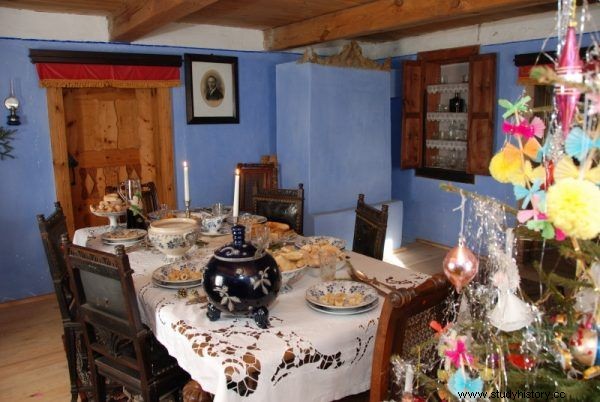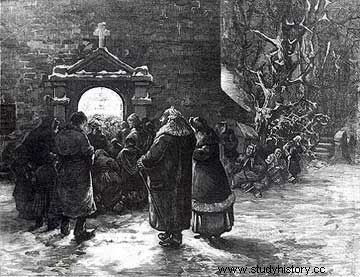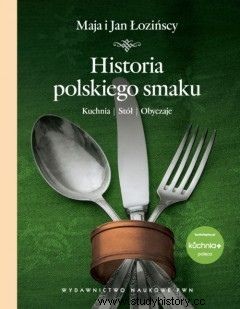At home it smells like gingerbread and Christmas tree, and carps are just going to the other world. We will also add a festive accent, although we can do without "Last Christmas", which all radio stations torment us with. Ladies and gentlemen, we invite you to the gentry Christmas Eve!
Already at the beginning of Advent, the pre-Christmas bustle began in the nineteenth-century court kitchen. The lady of the house was setting the preparation machine in motion and all the servants worked to make it before the first star.
At the very beginning, what required the greatest amount of work and time, i.e. preparation of Christmas meats. In order to have something to make them out of, first a bulky piggy had to say goodbye to life. After swine, the meat was divided into portions and its processing began. For some time, the court kitchen was filled with the smells of fried and boiled pork with the addition of herbs, spices and, for variety, other types of meat. Aromatic sausages, elegant pates and juicy hams were prepared. While the pates were enough to bake, the rest of the festive delicacies were a bit more western. One beautiful December morning, the smokehouse was lit and all day the cold cuts were "coming" in the smoke. This process itself had a huge impact on the taste of the meats. The smoke gave them a unique aroma, which depended on what wood was used for smoking and what was added to it (juniper twigs and berries, oak leaves, etc.). Some prepared cold cuts, others at the same time took care of sweet pastries.

Christmas in a country manor, staged by the Museum of the Mazovian Countryside in Sierpc.
The reign of sweet aromas began in the kitchen well in advance. It was, of course, the favorite time of children who tried by all means to ask the cook for a lick spoon or a handful of dried fruit (today they probably also wander around the kitchen hoping for some sweets?). Most often, the little household members managed to soften the heart of the cook who set the dough to maturing gingerbread, baking strudels, cakes and cookies. But woe to those children who were too insistent or too greedy - they were quickly driven out of the kitchen with empty hands.
The fish traditionally served for Christmas was prepared at the last minute to keep it fresh. As Maja and Jan Łoziński write in their book, "The History of Polish Taste", the morning catch on Christmas Eve belonged to the Christmas tradition . Nowadays, our Christmas catch is limited to pointing to fish in a supermarket tub and saying “Oh! This one, please! ”. Fishing for carp from under the ice in the manor's pond would probably be an interesting variety. As for the preparation of fish, about the famous "Greek", which no Greek knows from his homeland, rather than the cooks of the time. Instead of such inventions, they cooked, baked and fried without fancy, but with a great deal of variety. And carp was promoted to the absolute ruler of the Polish Christmas Eve table a bit later .

And after Christmas Eve everyone was in a hurry to Midnight Mass…
The morning of December 24 in the gentry's manor could not do without hunting which as one hunting superstition preached, would ensure health and prosperity throughout the year to come . Hunters, however, were not exempt from the traditional Christmas Eve fast! The hunted pheasants, rabbits, wild boars, foxes and partridges went to the court kitchen, and in the bellies of experienced shooters, herring, lenten borscht, as well as stew, potatoes from the fire and a glass of stew to warm up.
Meanwhile, the manor house was already bustling around the Christmas Eve table. Sheaves of un-threshed grain were placed in the corners of the dining room as a sign of future good crops, and under the tablecloth hay in memory of Jesus' birthplace. Then the table was covered with the best porcelain and the most beautiful cutlery. Place settings for the household members and the unexpected guest were placed on a solid dining table. In some courts, plates were also prepared for the dead and the absent.

The article is based on the book by Maja and Jan Łoziński "A History of Polish Taste" (PWN 2012).
When it was getting dark, the household members, fasted from the morning, gathered in the dining room and looked for the first star to the accompaniment of a piano or a march of empty bowels. And when that long-awaited spot finally cracked in the sky, everyone sat down at the table.
On beautiful platters there were crucian carp, perch, tench, pike, carp, dumplings, borscht and other traditional food, the lists of which were even given by some authors of guides for the ladies of the house. The revelers ate, savored, and finally began to sing Christmas carols. After the feast, in the festive mood of Wilija or Kucia, they were getting ready for the Midnight Mass, which was an obligatory element of this special evening. After returning from the solemn mass, it was considered that the fast was over and ... the festive feast began anew. Nobody was thinking about sleeping.
Sources:
Maja and Jan Łozińscy, History of Polish taste , PWN, Warsaw 2012.
